How To Start Affiliate Marketing Blogsite in 20 Minutes Using Bluehost
Step 1- Choose a name for your blog. Choose a name for your blog that is descriptive.
Step 2- Get your blog up and running. Get your blog registered and hosted.
Step 3- Personalize your blog. Pick a free blog design template and customize it.
Step 4- Create and publish your first blog post. Share your ideas with the rest of the world. This is the exciting part!
Step 5- Publicize your blog. With the right marketing, you can get more people to read your blog.
Step 6- Earn money by blogging. To monetize your blog, you have several options.
Why Blog?
- Share your experience. A blog allows you to express yourself and be heard. If you want, you can tell your story to the entire world. One of the most common applications of blogs is as a diary, in which the blogger writes about their daily experiences so that friends, family, and others can all be a part of their lives.
- Locate a community. At its core, blogging is an interactive medium. You make a post, and people respond to it. This is a great way to meet people who are interested in the same things you are. Blogging allows you to teach these people based on your experience while also allowing you to learn from your readers.
- Earn a living from home. If done correctly, blogging can be quite profitable. The world's top bloggers obviously make a lot of money, but even a part-time blogger can expect to make a nice profit if everything is done correctly. The best part is that blogging is a form of passive income because you can spend just a few hours a week writing a piece of content and then profit from it long after you've finished writing it. Later in this guide, I go into much more detail about how to blog for money.
- Appreciation for yourself or your company. A successful blog, on the other hand, turns your idea into a reality and can help you gain a lot of recognition in your field. Many bloggers have become known as experts solely because of their blogs, and some have even landed book and film deals as a result of their blogs.
Step 2- Get your blog up and running. Get your blog registered and hosted.
Now that you've decided on a name for your blog, it's time to get it online. This may appear difficult or technical, but the steps below will guide you through the process and make it simple.
You'll need two things to get your blog up and running: blog hosting (also known as web hosting) and blogging software. The good news is that these are usually sold together.
A blog host is a company that stores all of your blog's files and delivers them to users when they type in your blog's name. To have a blog, you must have a blog host.
You will also need software to create your blog. In this guide, I'll show you how to create a blog with WordPress blogging software, which is the most popular, customizable, and simple to use. Bluehost is the web host I recommend and demonstrate how to use in this guide. I personally use Bluehost and recommend them to all new bloggers for the following reasons:
- They will register your custom domain name for free, ensuring that it is not taken by anyone else.
- If you are dissatisfied for any reason, they will refund your money within 30 days.
- They provide a free, automatic WordPress blogging software installation (which I show you how to use in this guide).
- Since 2005, they have provided dependable web hosting that has been recommended by WordPress, and they currently host over 2 million blogs and websites.
- They provide helpful customer service via phone or web chat 24 hours a day, seven days a week.
1. Click here by November 28th to get the special Black Friday Sale price of $2.65 per month on BlueHost and then click “get started now”.
2. Select your plan. I recommend that beginning bloggers get the basic plan. Click “Select” to choose your plan.
3. Type in your domain name in the left box and then click “next” to start the registration process.
- If you already own a domain name and want to use it for your blog, type your existing domain in the right box and then click “next”. Only use the right box if you have previously paid to register a domain!
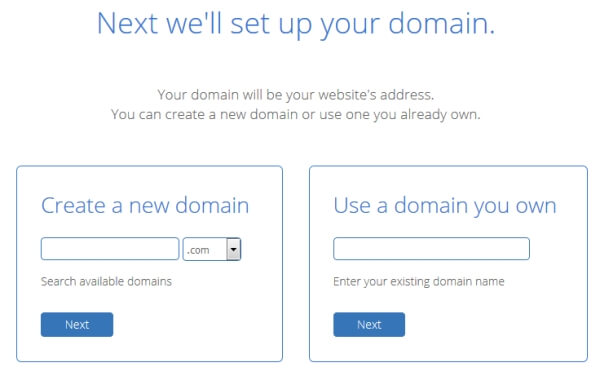
4. Fill out your billing details on the registration page.
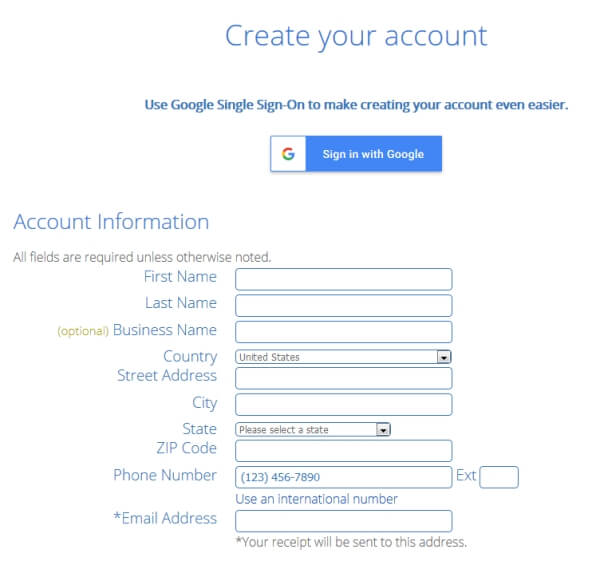
5. You will also need to choose your hosting package and options.
- Every BlueHost account plan has everything you need to get your blog up and running, including a free custom domain name, easy WordPress installation, web hosting, and custom email addresses (e.g. yourname@yourdomain.com).
- I uncheck the boxes next to the package extras except for “Domain Privacy & Protection”. While not strictly necessary, domain privacy keeps your personal information (name, address, phone, email) hidden from the public database of registered domain owners.
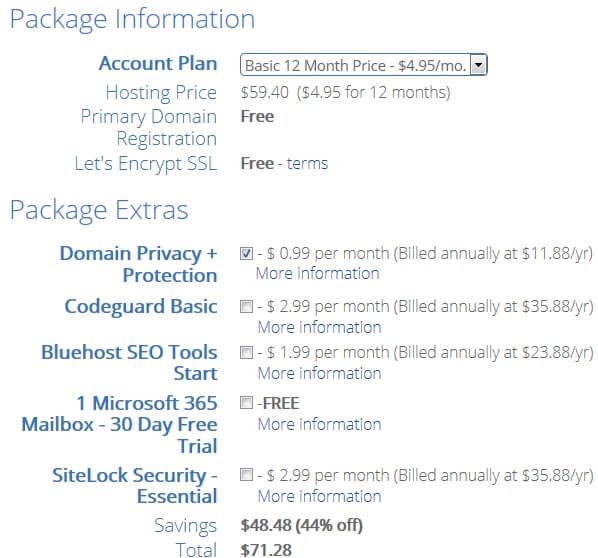
6. You will then need to create your BlueHost account and password.
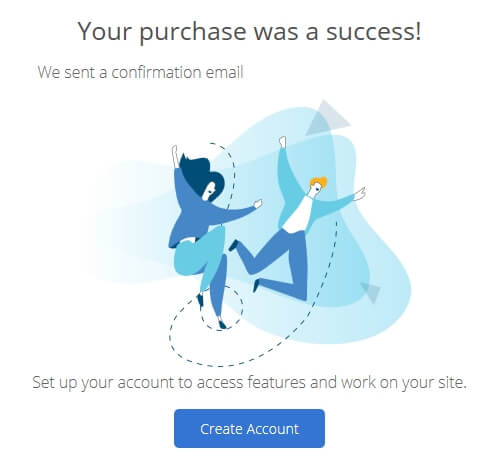
Once you do that you will be taken to an installation helper. Since you are following this tutorial you can just click “Skip this step” on the next few pages to be taken directly to the dashboard.
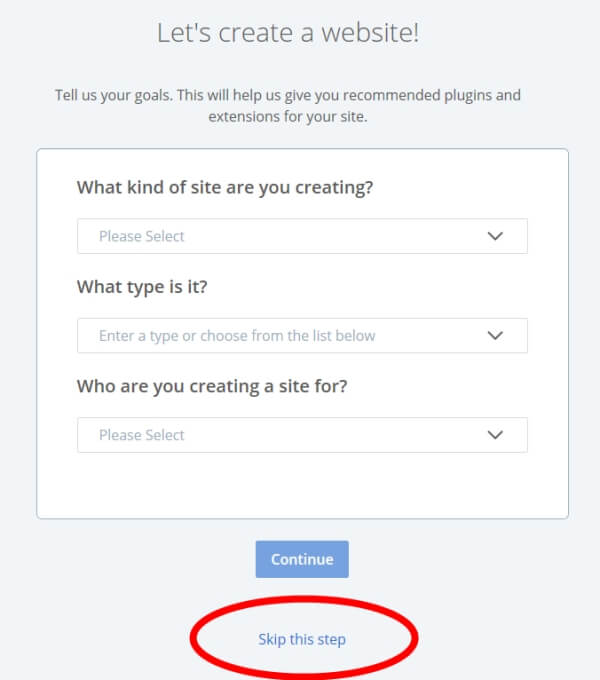
7. Install the WordPress blogging platform.
Now the system will install WordPress automatically. Once the install is complete click the blue “WordPress” button to be logged in to the administrator area of your blog.
Step 3- Personalize your blog. Pick a free blog design template and customize it.
Watch this video to see how a blog is customized
After logging in, you will be directed to your BlueHost Portal. From the portal, click the blue "WordPress" button to be automatically logged in to your WordPress blog.
Changing the look of your blog
You will be taken to the WordPress dashboard once you have logged in. This is where you can make any changes to your blog that you want.
Everyone has a different vision for how their blog should look. One of the best features of WordPress is the ability to change your entire layout and design with just a few clicks.
Blog layouts are referred to as "Themes" in WordPress. What exactly is a blog theme? Themes are in charge of the overall appearance of your WordPress blog. To change your theme, go to the left menu and select the "Appearance" tab.
You'll notice that several free WordPress themes have already been installed on your blog: Twenty Seventeen, Twenty Sixteen, and so on. These are attractive, well-designed themes that can be used for almost any type of blog. Many of the world's top bloggers, in fact, use one of these themes.
Unless you have a very specific design in mind for your blog, I recommend starting with one of these themes. Let's use the "Twenty Sixteen" WordPress theme as an example. Hover over the theme and click the "Activate" button to activate it on your blog. That's all! With a single click, you've changed the entire look of your blog!
If you don't like any of the pre-installed themes, you can easily switch to one of the thousands of other free WordPress themes. To install a new WordPress theme, go to the left menu and select "Appearance," then "Add New Theme."
This is the theme search page for WordPress. There are literally thousands of different themes to choose from. You can easily change your entire design by activating a new WordPress theme at any time. To find a theme you like, go to the "Popular" tab and start browsing. When you've found one you like, press the blue "Install" button.
After installing the theme, click "Activate" to activate it on your blog. Visit your blog to see how your new theme looks in action!
Changing your theme is the most basic way to customize your WordPress blog, but there are numerous other options. You can also see me completely customize a WordPress blog from scratch in the video above.
Step 4- Create and publish your first blog post. Share your ideas with the rest of the world. This is the exciting part!
It's time to start blogging now that your blog is up and running! Let's get started on your first piece of content.
Go to the left menu and select "Posts."
You'll notice there's already a post there. This is a standard post that appears on every new WordPress blog, and we don't need it. To delete it, click the "Trash" button below the post.
Click the "Add New" button to begin writing a new post.
You've arrived at the post editor's interface. Enter your post's title in the top box, and then begin writing your post in the lower box.
To add a picture to your post, click the "Add Image" icon and then "Upload" to select a picture from your computer. On the following screen, you can change the size of the image. When you're finished, click "Insert into post" to insert the image.
Once you've finished your post, simply click the "Publish" button in the top right corner of the screen to publish it.
Content to Should Include on the Blog
Your blog should provide two types of content: static content and dynamic content.
Static Content: Your blog should have a few pages that are specifically designed to provide the visitor with the tools they require. The content on these pages is static, which means that it does not change frequently, if at all. These are primarily top-level pages that can be accessed via your blog's menu.
These static content pages should be in place before you launch your blog to the rest of the world.
Include the following static pages:
About Us (Me) – A biographical summary of the author(s) as well as a mission statement should be included on this page. Consider the answers to the following questions: How did your interest in the subject grow? What message do you want to send to the rest of the world? What is your long-term goal?
Contact-A contact page gives the visitor a way to contact the author, which gives the visitor confidence that you are a real and reachable author. You can enter your physical address, phone number, and email address. To keep your personal identifying information private, you can also use a simple contact form. You should also include links to all of your social media profiles here.
Aside from your blog, which is usually introduced on the home/main page, these two crucial pages should be visible and easy to access on your top (header) menu. You can see how I have these pages included in the header menu at the top of this page. If you need assistance, see this detailed guide to customizing your blog menus.
Other static pages that are equally important but are less commonly considered are:
Disclaimer Page: If you plan to monetize your blog, you must describe how you plan to make money. According to FTC guidelines, this is an absolute must-have page that should not be overlooked. For example, if you are discussing and endorsing a product and stand to profit by linking to the product, you must disclose this relationship.
Privacy Policy: If you collect data from your visitors in any way, you must include a privacy policy page that informs visitors about how you collect data, how you use it, and if you share that data. A Privacy Policy is required if you use Google Adsense or a Google Analytics account on your blog. The CCPA (California Consumer Privacy Act) and the GDPR (General Data Protection Regulation) both require this page, which is included by default on your WordPress blog.
Terms of Service: If your blog also operates a store or sells services, a Terms of Service page is a good idea to reduce your potential liability.
These required static pages are typically linked to in a blog's footer menu. They should be visible and accessible from the home page at the very least. Again, scroll down to the bottom of this page to see how this works in practice.
Other static pages can be included if they are appropriate for your blog and business. An advertising page to solicit paid advertisements, a donations page, a resource page to direct visitors to your favorite links within your field, and a page for submitting ideas and content are all examples of static pages.
Dynamic Content: Your blog is your dynamic content, and it is the most important content you have to offer. This is where you, as the creator, will infuse your brand of informative content into the blog, providing your audience with knowledgeable tips, facts, opinions, and stories. This is how you keep your visitors interested and coming back for more.
Your blog content should be updated at regular intervals. Waiting months to create content will never result in a growing audience. Posting content on a weekly basis and driving traffic to these posts will aid in the development of your brand.
How to Create Outstanding Blog Content
Each post should be detailed, informative, and entertaining. It's not always easy to come up with new blog post ideas on a regular basis, and you can experiment with tone and even subject matter to keep things lively and interesting. After all, it's your space. However, there are a few elements that every piece of content should strive to include.
Define the Content:
Create an enticing post title that piques readers' interest and encourages them to click. Use the first paragraph of your post to clearly define your article's topic and to provide a possible hook to keep the reader reading.
Engage Your Reader: At the end of each post, a common tactic for engaging visitors is to pose a meaningful question to your audience and ask them to respond in the comments. This simple measure has the potential to increase engagement considerably
The more information and detail you include, the better. Visitors, on the other hand, will begin to skim if the content contains lengthy paragraphs a mile long, and they will exit faster than they came in. Tidbits are popular among visitors. Use short paragraphs with spaces between them, lists and standout quotes, images, and always include headings and sub-headings to help visitors find what they're looking for.
Original Photos
While it is simple to include stock images from free image sites, it is even better to include your own photos and graphic work. Another option is to use free images and edit them with a free photo editor.
Edit Your Work
Your blog's content should be well-edited. Nothing says unprofessionalism like a myriad of typos and grammatical mistakes. Consider using a writing application software like Grammarly.
Putting Your Blog Online
Even after you've published a post, your blog may still display a placeholder page.
When you're ready to make your blog public for the first time, go to your WordPress dashboard and click the "BlueHost" menu at the top left of the menu, then click the blue "Launch" button to remove the placeholder page and launch your blog.
Step 5- Publicize your blog. With the right marketing, you can get more people to read your blog.
Creating a well-designed blog and writing excellent content is only the beginning. You will need to spend some time promoting your blog in order to get visitors, especially when you first start.
The strategies listed below will assist you in getting your blog in front of more readers. You don't have to use every strategy; try a few and see which ones work best for you.
Notify Your Inner Circle
Your inner circle should be the first to become aware of your blog. This includes family members, friends, and coworkers in your field. Encourage them to follow you, request that they mention your new blog, and, most importantly, thank them.
Use Social Media
Regular posting is required.
Regularly publish new content. Make and stick to an editorial calendar. To begin, a good blogger should post at least once per week. Your followers will drop off if you have long gaps between posts, and your growth will be severely hampered. It's not easy to post on a regular basis, but it's something you must do.
Create an Email list
In addition to attracting new visitors to your blog, you will want to ensure that your current visitors return. This is where email marketing comes into play. You can notify your visitors when you post new content on your blog by collecting their email addresses (with their permission, of course). This keeps people returning to your blog, which not only increases your readership over time but also allows you to develop a closer relationship with your visitors.
Make your blog search engine friendly.
You want your blog to appear as soon as possible in search results.
Google: Create a Google Webmaster account and access the Search Console. To add your blog, click "Add Property" and follow the on-screen instructions.
Bing: Create a Bing Webmaster account and add your blog to it.
Submitting your blog is the first step in the search engine optimization process (SEO).
Step 6- Earn money by blogging. To monetize your blog, you have several options.
Offering Goods and Services
Selling your own products and services directly through your blog is an excellent way to supplement your income. Your products and services will begin to sell themselves as your blog grows and attracts a larger audience.
Use visual images and a link to your storefront page in your blog's sidebar to increase the visibility of what you sell.
FAQS
Where is the best place to put your blog
In this page's tutorial, I show you how to set up your blog with BlueHost and WordPress.org. This is referred to as a self-hosted WordPress blog, and it is what I use for this blog and recommend to all of my readers. When you sign up with BlueHost, you will receive a free domain name and WordPress (WordPress.org) will be installed automatically on your BlueHost account. You can start blogging as soon as your account is activated. Simply follow the steps in the tutorial on this page to easily customize your self-hosted WordPress blog.
How much money does it take to start a blog?
A blog can be created for absolutely nothing. It doesn't cost anything.
But let's be honest. You can't just get a subdomain from a free blogging site like Blogspot if you want your blog to be taken seriously. Instead, you should choose and register a custom domain name. On average, domain names cost around $15 per year. So you're now a whopping $15 in debt.
However, one of the many web hosting companies is the best place to start your blog. The best web hosting option is a WordPress hosting account from Bluehost, which costs $2.75 per month and includes free domain name registration, for a total cost of $33 per year.
How Do Bloggers Earn Money?
Bloggers can earn a full-time living solely from their blogs. Some bloggers earn hundreds of thousands of dollars each year. While becoming a well-paid blogger is not easy, it is entirely possible. It takes a lot of hard work and time, just like any other business: Bloggers can earn through the following channels>
Affiliate Programs: Affiliate advertisements are a popular way to monetize a blog. These advertisements direct visitors to a product or service available on another website. If a sale is made as a result of a click on your blog, you will receive a commission, and some commissions can be very high. Affiliate programs can be found in individual stores as well as on large-scale platforms like Amazon.
Contextual Ads: With Google Adsense, you can place a small piece of code on your blog that dynamically displays ads related to your content. When one of your readers clicks on an advertisement, the advertiser pays Google, and Google sends you a percentage of the revenue.
Sponsored Posts: Rather than advertising on the entire blog, advertisers can pay a lower fee to sponsor individual posts. This is an excellent method for monetizing new blogs.
Advertisements: As your blog gains traction and a healthy number of daily visitors, advertisers may be willing to pay a premium for a well-placed ad on your blog.
What are the other Hosting Companies comparable to Blue Host?
The following are the hosting companies that compare with Bluehost. You can access their detailed comparison with Bluehost by clicking on them.



















.%20The%20background%20shows%20a%20search%20engine%20results%20page%20(SERP)%20with%20a%20highlighted%20top.webp)
Comments
Post a Comment